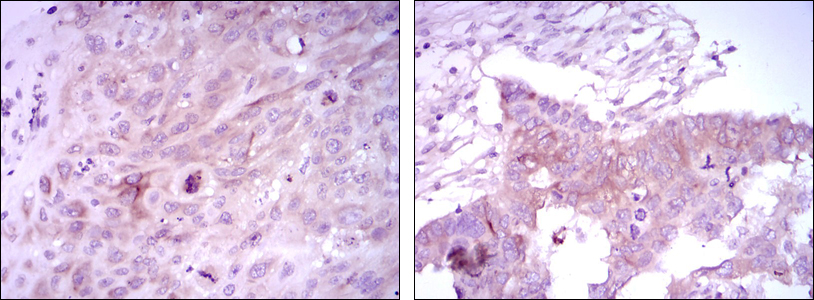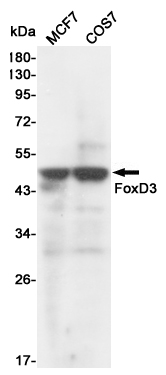-
Product Name
Anti-FOXD3 (3D11) Mouse antibody
- Documents
-
Description
FOXD3 (3D11) Mouse monoclonal antibody
-
Tested applications
WB, IHC-P
-
Species reactivity
Human, Mouse, Monkey
-
Isotype
Mouse IgG1
-
Preparation
Antigen: Purified recombinant fragment of human FOXD3 expressed in E. Coli.
-
Clonality
Monoclonal
-
Formulation
Ascitic fluid containing 0.03% sodium azide.
-
Storage instructions
Store at 4°C short term. Store at -20°C long term. Avoid freeze / thaw cycle.
-
Applications
WB: 1/500 - 1/2000
IHC: 1/200 - 1/1000
ELISA: 1/10000
-
Validations

Immunohistochemical analysis of paraffin-embedded lung cancer tissues (left) and ovarian cancer tissues (right) using FOXD3 mouse mAb with DAB staining.

Western blot detection of FoxD3 in MCF7 and COS7 cell lysates using FoxD3 mouse mAb (1:1000 diluted).Predicted band size:48KDa.Observed band size:48KDa.
-
Background
Swiss-Prot Acc.Q9UJU5.FoxD3 is a member of the Forkhead Box family and is characterized by a winged-helix DNA-binding structure and the important role it plays in embryonic development . This transcriptional regulator is required for the maintenance of pluripotency in the pre-implantation and peri-implantation stages of mouse embryonic development and is also required for trophoblast formation. FoxD3 is required for the maintenance of the mammalian neural crest; FoxD3(-/-) mouse embryos fail around the time of implantation with loss of neural crest-derived structures. FoxD3 also forms a regulatory network with Oct-4 and NANOG to maintain the pluripotency of ES cells. Promotes development of neural crest cells from neural tube progenitors. Restricts neural progenitor cells to the neural crest lineage while suppressing interneuron differentiation. Required for maintenance of pluripotent cells in the pre-implantation and peri-implantation stages of embryogenesis. Tissue specificity: Expressed in chronic myeloid leukemia, Jurkat T-cell leukemia and teratocarcinoma cell lines, but not in any other cell lines or normal tissues examined.
Related Products / Services
Please note: All products are "FOR RESEARCH USE ONLY AND ARE NOT INTENDED FOR DIAGNOSTIC OR THERAPEUTIC USE"
